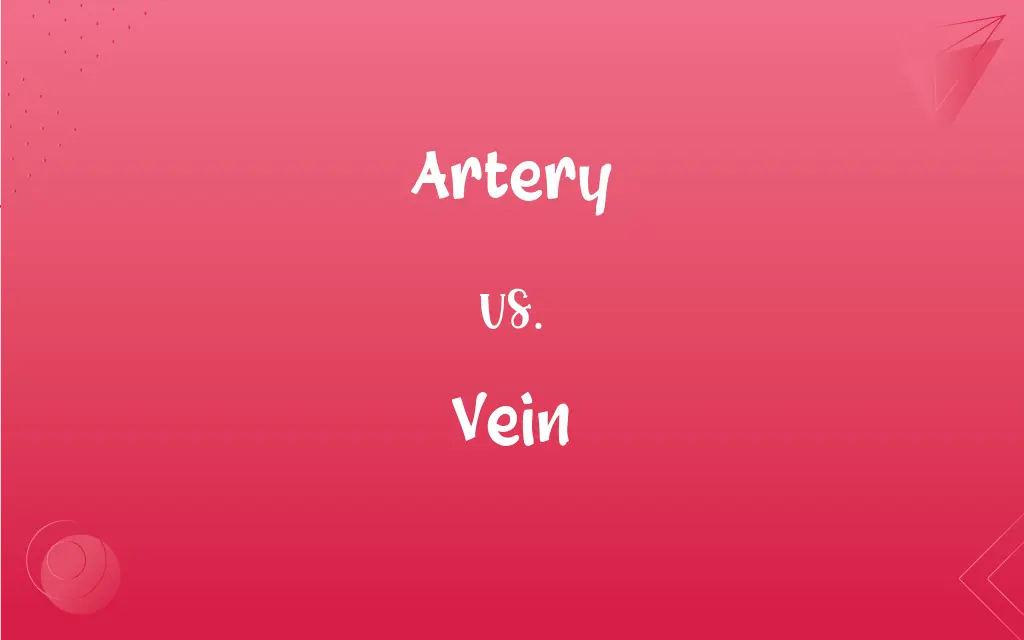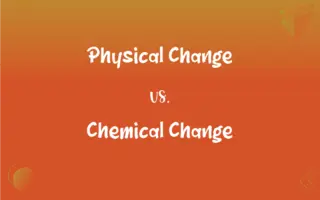Artery vs. Vein: What's the Difference?
Edited by Aimie Carlson || By Harlon Moss || Updated on October 12, 2023
An artery carries oxygenated blood from the heart to the body, while a vein carries deoxygenated blood from the body to the heart. Both are vital, tubular structures ensuring circulatory wellness.

Key Differences
The artery plays a crucial role in the circulatory system by transporting oxygen-rich blood (except for the pulmonary artery) from the heart to various parts of the body. On the other hand, the vein diligently carries oxygen-poor blood, usually indicated by a darker hue, from different body parts back toward the heart, ensuring a consistent circulatory loop.
In terms of structural nuances, the walls of an artery are generally thicker and more elastic to accommodate the high-pressure blood flow directly from the heart. Contrastingly, the vein incorporates valves within its relatively thinner walls, which facilitate the upward flow of blood back to the heart, preventing any backward leakage in the low-pressure system.
Observing their anatomical distribution, arteries, due to their robust structure, are typically located deeper within the body, safeguarding them from potential injury. Differing in approach, veins often course closer to the skin’s surface, which is why they may be visibly perceptible, especially in areas like the arms and legs.
Upon inspection of their medical significance, when an artery is blocked or damaged, it can precipitate critical conditions, like strokes or heart attacks, due to the impediment of oxygen supply to vital organs. Alternatively, issues with veins, such as varicose veins or venous insufficiency, while they can lead to complications, often present initially less acutely, involving symptoms like swelling or visible vein patterns.
From a surgical and medical procedure perspective, arteries are often accessed for procedures like angioplasty due to their direct pathway to the heart and other organs. Veins, being more accessible, are typically the site for intravenous (IV) line insertion, blood draws, and other related medical interventions due to their surface proximity and lower pressure, minimizing potential complications.
ADVERTISEMENT
Comparison Chart
Blood Oxygen Level
Usually carries oxygenated blood.
Generally carries deoxygenated blood.
Wall Thickness
Thicker and more elastic walls.
Thinner walls with valves.
Location in Body
Typically found deeper within the body.
Often located closer to the skin surface.
Medical Urgency when Damaged
Can precipitate urgent crises like heart attacks.
Complications, while serious, may develop more slowly.
Usage in Medical Procedures
Utilized in procedures like angioplasty.
Commonly accessed for IV lines and blood draws.
ADVERTISEMENT
Artery and Vein Definitions
Artery
An artery is a blood vessel transporting blood away from the heart.
The aorta is a major artery that directs blood from the heart to the rest of the body.
Vein
Veins possess valves to prevent the backflow of blood.
Valves in the vein ensure blood travels toward the heart against gravity.
Artery
Arteries typically carry oxygenated, nutrient-rich blood.
The coronary artery supplies oxygenated blood to the heart muscle itself.
Vein
Veins are vessels responsible for returning blood to the heart.
The superior vena cava returns blood from the upper body to the heart.
Artery
The walls of arteries are muscular and elastic to withstand pressure.
The elasticity of the artery helps accommodate the pulsating flow of blood.
Vein
Veins typically transport deoxygenated blood, with exceptions like pulmonary veins.
Pulmonary veins uniquely carry oxygenated blood to the heart from the lungs.
Artery
The artery system branches into smaller vessels called arterioles.
Arterioles further branch to distribute blood to various bodily tissues.
Vein
Veins can become enlarged or twisted, known as varicose veins.
Varicose veins, often in legs, may cause discomfort or aesthetic concern.
Artery
Arteries can be categorized into elastic and muscular types.
The femoral artery, a muscular type, delivers blood to the lower limb.
Vein
Spider veins are smaller, visible veins often noticed on the skin surface.
Some people seek treatment for spider veins for cosmetic reasons.
Artery
(Anatomy) Any of the muscular elastic tubes that form a branching system and that carry blood away from the heart to the cells, tissues, and organs of the body.
Vein
(Anatomy) Any of the membranous tubes that form a branching system and carry blood to the heart from the cells, tissues, and organs of the body.
Artery
A major route of transportation into which local routes flow
Traffic was heavy on the central artery.
Vein
A blood vessel of any kind; a vein or artery
Felt the blood pounding in her veins.
FAQs
What role does a vein play in circulation?
A vein carries blood from various body parts back to the heart.
Are there instances where arteries carry deoxygenated blood?
Yes, the pulmonary arteries carry deoxygenated blood from the heart to the lungs.
Can surgeries be performed on arteries and veins?
Yes, surgeries like bypass grafts for arteries and varicose vein removal for veins are common.
How do veins prevent backflow of blood?
Veins prevent blood backflow by utilizing valves that permit blood flow in one direction—towards the heart.
Can arteries and veins repair themselves after injury?
To a degree, arteries and veins can heal after minor injuries, but significant damage may require medical intervention.
What lifestyle choices impact arterial health?
Choices like a balanced diet, regular exercise, and avoiding smoking significantly impact arterial health positively.
Do veins ever transport oxygenated blood?
Yes, pulmonary veins carry oxygenated blood from the lungs to the heart.
Why is the pressure higher in arteries than in veins?
The pressure is higher in arteries because they receive blood directly from the heart, which pumps with significant force.
Why do veins appear blue under the skin?
Veins may appear blue due to light wavelengths penetrating and reflecting off the skin, not because the blood is blue.
Can wearing certain clothing affect vein health?
Yes, consistently wearing overly tight clothing may impact blood flow and potentially contribute to vein issues.
How does the wall structure of an artery differ from a vein?
Arteries have thicker, more elastic walls compared to veins, which have thinner walls with valves.
What could happen if an artery becomes blocked?
A blocked artery can cause life-threatening events like heart attacks or strokes, depending on its location.
What complications can arise from problematic veins?
Issues with veins, like varicose veins, can cause pain, swelling, and potentially venous ulcers or blood clots.
Are there differences in the appearance of arteries and veins in medical imaging?
Yes, arteries and veins may appear differently on imaging like Doppler ultrasounds due to blood flow direction and speed.
Is it possible to live with certain arterial or venous conditions?
Yes, with appropriate management and medical guidance, many people live with arterial and venous conditions.
What is the general function of an artery?
An artery transports blood from the heart to other parts of the body.
Can arteries and veins be damaged or diseased?
Yes, both arteries and veins can be afflicted with various conditions, like atherosclerosis in arteries and varicose veins in veins.
What could be a reason for artery hardening?
Arteriosclerosis, often due to factors like aging and lifestyle choices, can lead to artery hardening.
How does the vena cava function in the venous system?
The vena cava (superior and inferior) is crucial for returning deoxygenated blood from the body back to the heart.
What’s the significance of the aorta in the arterial system?
The aorta is the largest artery, originating from the heart, and it distributes blood to numerous smaller arteries throughout the body.
About Author
Written by
Harlon MossHarlon is a seasoned quality moderator and accomplished content writer for Difference Wiki. An alumnus of the prestigious University of California, he earned his degree in Computer Science. Leveraging his academic background, Harlon brings a meticulous and informed perspective to his work, ensuring content accuracy and excellence.
Edited by
Aimie CarlsonAimie Carlson, holding a master's degree in English literature, is a fervent English language enthusiast. She lends her writing talents to Difference Wiki, a prominent website that specializes in comparisons, offering readers insightful analyses that both captivate and inform.































































